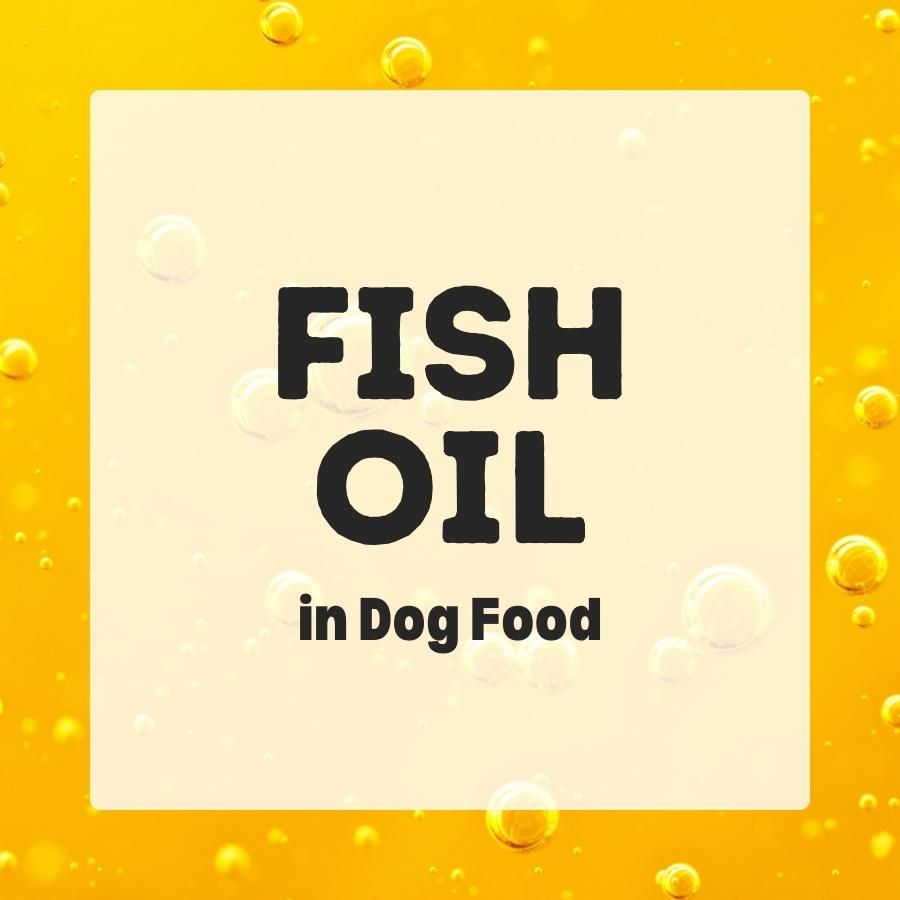Fish oil in dog food is used to provide lots of beneficial omega-3 fatty acids. It’s typically extracted from small marine oily fish.
Contents
What is Fish Oil?
Fish oil is cold-pressed or otherwise extracted while making fish meal and is often refined to remove impurities.
According to the AAFCO, this fish ingredient is simply defined as “the oil from rendering whole fish or cannery waste“[1].
Fish oil is a common ingredient in many dog foods produced by the US pet food industry. Each year, around 5.100 tons of fish oil are used in the production of pet foods[8].
The fish used to make fish meal and fish oil are typically small, bony, and oily species such as anchovy, herring, capelin, or menhaden.
These fish are not in high demand for human consumption due to their small size and strong oily taste.
But almost half of all fish oil today comes from the recycling of by-products such as heads, tails, fins, and offal from filleting or cannery operations. These oils can also from edible fish such as tuna, cod, haddock, hake, salmon, and pollock[11].
The composition of fish species used in fish meal and fish oil production can vary, so it is often sold under a generic name.
But there are different types of named fish oils available, e.g. salmon oil or menhaden oil which some brands opt to use.
The process of making fish meal begins by cooking and pressing the raw material. This removes a mixture of fish oil, water, and soluble protein. This liquor is then centrifuged to separate the oil, which is often further refined before being stored.
In dry dog food, fats are typically added to the surface of the finished kibble after extrusion and drying. Fish oil is usually added at very small inclusion levels of 1-2% per formula.
However, there are few dog foods high in fish oil since the high levels of unsaturated fats make it prone to oxidation.
Fish oil is often preserved with antioxidants such as ethoxyquin or tocopherols to protect it from going rancid during storage.
One problem is the potential presence of fat-soluble pollutants such as PCBs and dioxins in fish oil supplements. So suppliers of fish oil have to make sure to stay below maximum limits.
Overall, fish oil is a valuable ingredient, providing flavor and essential omega-3 fatty acids that can benefit your pet’s health.
Fish Oil Nutrients
Dog food with fish oil provides beneficial fats to your canine’s diet.
Marine fish oils are rich in omega-3 fatty acids such as eicosapentaenoic acid (EPA) and docosahexaenoic acid (DHA)[3,7].
By the way, the fish processed into fish oil do not actually produce omega-3 fatty acids themselves.
Instead, they accumulate these fats while feeding on single-celled microalgae better known as phytoplankton.
But the fatty acid profile of the different fish oils can vary substantially by processing method, quality of raw materials, fish species, time of year or plankton the fish fed on[6,10].
Benefits of Fish Oil
Fish oil provides energy, flavor, texture, and nutrients.
The omega-3 fatty acids EPA and DHA found in fish oil are known to reduce inflammation in the body.
They benefit in cognitive health and puppy development, have therapeutic effects on a variety of conditions, and help to maintain vision, and healthy skin and coat[9,12,13].
Fish oil supplements can reduce the O6:O3 ratio and are often recommended for dogs with skin issues or to improve the symptoms of canine osteoarthritis[4,5].
While the impact of fish oil as a pain reliever seems to be rather weak it can still improve the overall quality of life[3,4].
Fish Liver Oil
Vitamin A is essential for good vision, healthy skin, and a strong immune system. Vitamin D is important for healthy bones and teeth, as well as for the absorption of calcium and phosphorus.
Both of these vitamins are found at high levels in cod liver oil. It is not even classified as fat but as a vitamin ingredient[1].
All in all, this is a specialty fish oil processed from the livers of the fish family Gadidae, a family of marine fish known as cod or codfish.
Further Reading
[1] AAFCO Official Publication. Chapter 6. Free Access.
[2] Ravić et al. The Effect of Fish Oil-Based Foods on Lipid and Oxidative Status Parameters in Police Dogs. Biomolecules. 2022. https://doi.org/10.3390/biom12081092
[3] Beynen. Fish oil in mobility foods for dogs. Creature Companion. 2016
[4] Hielm-Björkman et al. An uncommissioned randomized, placebo-controlled double-blind study to test the effect of deep sea fish oil as a pain reliever for dogs suffering from canine OA. BMC Vet Res. 2012. https://doi.org/10.1186/1746-6148-8-157
[5] Mehler et al. A prospective, randomized, double blind, placebo-controlled evaluation of the effects of eicosapentaenoic acid and docosahexaenoic acid on the clinical signs and erythrocyte membrane polyunsaturated fatty acid concentrations in dogs with osteoarthritis. Prostaglandins Leukot Essent Fatty Acids. 2016. https://doi.org/10.1016/j.plefa.2016.03.015
[6] FAO, Fishery Industries Division (1986): The production of fish meal and oil. Chapter 10.2 Fish Oil.
[7] European Fishmeal and Fish Oil Producers: Fishmeal and fish oil.
[8] Pet Food Production and Ingredient Analysis (PDF). 2020. Institute for Feed Education and Research (IFEEDER), North American Renderers Association (NARA), Pet Food Institute (PFI)
[9] de Godoy et al. Influence of feeding a fish oil-containing diet to young, lean, adult dogs: effects on lipid metabolites, postprandial glycaemia and body weight. Archives of Animal Nutrition. 2015. https://doi.org/10.1080/1745039X.2015.1100866
[10] Aldrich: Rendered Products in Pet Food. Published in Essential Rendering (pdf). 2006.
[11] IFFO – The Marine Ingredients Organisation: Update on by-product marine ingredients.
[12] Bauer. The essential nature of dietary omega-3 fatty acids in dogs. Journal of the American Veterinary Medical Association. 2016. https://doi.org/10.2460/javma.249.11.1267
[13] Kaur et al. Role of Omega-3 Fatty Acids in Canine Health: A Review. International Journal of Current Microbiology and Applied Sciences. 2020. https://doi.org/10.20546/ijcmas.2020.903.259
